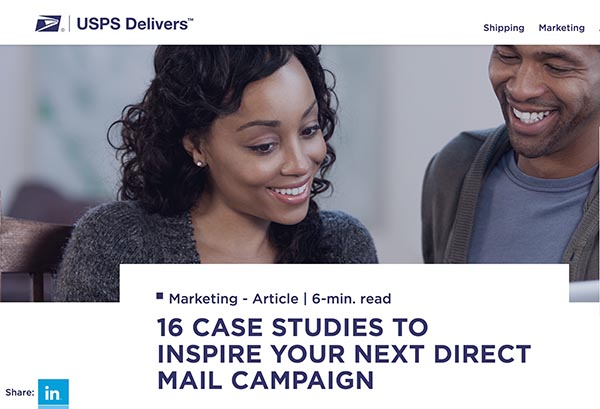Recently, I’ve been thinking about demand creation for print. How do you do it? Whose job is it? Who’s doing it well? One of the organizations especially proactive in this effort is the U.S. Post Office.
Clearly, the USPS has a vested interest in the success of direct mail. To this end, it has a terrific blog post called “16 Case Studies to Inspire Your Next Direct Mail Campaign.” The post breaks down 16 case studies into different categories, from augmented reality and NFC to dimensional mail. Here is my synthesis of three of these examples to give you an idea of the flavor.
Creating a Unified Sports Experience
When marketers put on an event, they want attendees to have a positive and unified experience. For one organized sports event, organizers added more than 50 unique QR Codes to signage, publications, e-tickets, and more. By scanning these codes, attendees could access additional information, share experiences through social media, and access the mobile store and download official apps. The results?
- QR Code users scanned event material an average of 1.6 times.
- Attendees most likely to scan the QR Codes were ages 55+.
- QR Codes helped the organizers reach total app downloads of 15 million.
This is great information the company will likely put to good use!
“Not Like Any Other F****N Dinner!”
Another way to get readers to engage with a direct mail piece is specialty inks. To promote these opportunities, the USPS used (among others) a case study from Knorr.
Knorr wanted something truly different to promote its new line of frozen foods. It created a mailer with the line “unlike any F****N dinner you’ve ever tried” printed in leuco dye. Recipients were asked to put the piece into their freezer, and as the temperature changed, the dye changed color and the paper revealed a whole new message: “FROZEN meals can be this delicious!”
The campaign was so successful that half of the company’s mailing had to be postponed so that stores could manage the demand. The campaign achieved an average response rate of 10.2%.
Give It Shape
Another way to engage customers with direct mail is sending fun and unusual shapes. To show the effectiveness of this approach, the USPS featured the experience of a telecom company that also wanted to test shaped mailers against other formats.
To see which type of mailer would drive more customers to its high-speed Internet business, the company sent out four different types of cards—a pop-up mailer, USPS Customized MarketMail® (a relatively new postal classification that allows marketers to mail nonrectangular and irregular-shaped mail pieces without having to put them in a package or envelope), a plastic mailer, and simple cardstock. Customized MarketMail® had the highest average response rate of 2.1%.
These are three great examples, and there were 13 more.

Here is what I love about this post:
Variety of formats. The post covers QR Codes, augmented reality, NFC, Video in Print, mobile-in-print, conductive inks, Customized MarketMail®, and 3D mail. Not only does the post show just how varied direct mail can be, but it highlights the myriad ways to actively engage a target audience.
Specificity. All of the case studies have details about specific campaigns. Most have at least some level of metrics to give readers a sense of how the campaigns fared. It’s easy to say that a direct mail campaign was a success, but the USPS had metrics to back it up.
Variety of market verticals. The case studies crossed market verticals: telecommunications, retail, broadcast television, organized sports, cosmetics, consumer foods, among others. The inclusion of so many markets sends a powerful message that is ultimately the one the USPS wants to convey: direct mail is for everybody.
If you’re looking to do demand generation, this is a great example of how to do it well. Check it out.










Discussion
By Andrew Schipke on Aug 02, 2018
Heidi, Just a FYI - the USPS is now approving shaped envelopes or "TED-C" as the USPS calls them (Trailing-Edge-Die Cuts) for full automated postage discounts as opposed to much higher Customized Market Mail rates which will benefit direct mail demand creation. Initial reactions have been very strong to shape based envelopes not only because of thier uniqueness in the mail stream but also the lower postage rates. Currently 8 shapes have already been approved by the USPS. MTAC- Group# 188 is working on the guidelines for accelerated additional approval of shaped envelopes.
Discussion
Join the discussion Sign In or Become a Member, doing so is simple and free